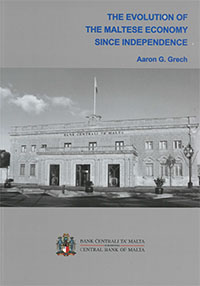 |
Understanding the Maltese Economy
This book brings together ten research articles that assess macroeconomic relationships in Malta, while trying to explain the main factors that led the Maltese economy to grow strongly during the first decade following EU accession. The first part of the book gives a general overview of the Maltese economy and highlights the trends and structural changes that have contributed to increase economic flexibility and resilience. The second part looks at the relationship between output, prices and employment, providing estimates of potential output, Okun's law and the Phillips relationship in Malta. Inflation dynamics are analysed in greater detail in the third part, with articles focusing on the underlying patterns and determinants of inflation and estimates of core inflation. The role of the financial system is analysed in the fourth section, particularly the demand for currency and the transmission mechanism. Estimates of the fiscal multipliers for the Maltese economy are discussed in the final section.
Specifications
- 122pp
- 210 x 297 mm
- Soft cover
- ISBN: 978-99957-875-2-3 (print)
- ISBN: 978-99957-875-3-0 (online)
Printed by Gutenberg Press, Malta
Year of Publication: 2016
|
 |
The Evolution of the Maltese Economy since Independence
This study surveys the performance of the Maltese economy in the first half century since independence. The picture that emerges is of a nation that has benefitted from an extraordinary rate of economic growth and a significant reduction in volatility. The Maltese economy has matured exceedingly rapidly, with cycles of inflation and unemployment becoming much less pronounced and with a consistent underlying downward trend. The economic structure has shifted strongly towards services, which has led to an increased demand for labour that has accommodated the secular rise in female participation. The role of the state has changed dramatically, though as in other small open economies it continues to play a relatively more active economic function. The financial system has also altered beyond recognition, playing a more direct role in affecting economic activity. While the Maltese economy faces significant challenges, the strengths developed since independence will stand it in good stead.
Specifications
- 39pp
- 210 x 297 mm
- Soft cover
- ISBN: 978-99957-875-0-9 (print)
- ISBN: 978-99957-875-1-6 (online)
Printed by Gutenberg Press, Malta
Year of Publication: 2015
|
 |
The Central Bank of Malta
This 16-page brochure takes a look at the basic tasks and main characteristics of the Central Bank of Malta and text is in both Maltese and English. The target readership is students from secondary school level onwards and the general public.
Anyone interested may collect a free copy from the Central Bank of Malta.
Specifications
- Illustrated in colour
- 16pp
- 210 x 250 mm
- Soft cover
- ISBN: 978-99932-0-905-8 (print)
- ISBN: 978-99932-0-906-5 (online)
Printed by Gutenberg Press, Malta
Year of Publication: 2010
|
 |
The Central Bank of Malta – The Building and its History
by Kevin Cassar
This booklet, published on the 40th anniversary of the Central Bank of Malta, traces the history of the building presently occupied by the Bank and its historic antecedents. The Central Bank of Malta lies perched on the heights occupied by St James Bastion. This bastion was one of the first defensive ramparts built when the Knights of St John undertook the construction of a new fortified city, Valletta, in 1566, only a few months after the lifting of the Great Siege of 1565. For almost three hundred years, St James Bastion and the formidable Cavalier bearing the same name were a bulwark of Valletta’s land defences. In 1872 the British Military Authorities chose the wide expanse of St James’ Bastion in order to build a gymnasium for the use of the garrison of Valletta and Floriana. During the First World War the Gymnasium was turned into a soldiers and sailors institute for the benefit of the thousands of British and Commonwealth servicemen then recovering in Maltese hospitals. A bequest left by the 8th Baron Vernon, who died in Malta during the Great War, resulted in the building of the Vernon United Services Club on the site of the former Gymnasium. This institution was opened by the Governor of Malta, Sir Walter N Congreve, in 1924. The Vernon Club maintained its function as a services social club until 1967, when the building was handed over to the Government of Malta in order to house the Central Bank of Malta, which had been created by an Act of Parliament that same year.
Book Specifications
- Illustrated in colour
- 48pp
- 165 x 230 mm
- Soft cover
- ISBN -13: 978-99909-975-5-1
Printed by Gutenberg Press, Malta
Year of Publication: 2008
|
 |
Currency in Malta
by Joseph C Sammut
Joseph C. Sammut has made it his life's task to study the ramifications of the currencies in use in the Maltese Islands down the ages. Starting with the Carthaginians, he passes on to discuss the currencies of the Romans, Byzantines (by way of the Vandals), Arabs, Normans, Suabians, Angevins, and Aragonese. He writes in exhaustive detail starting with the arrival of the Order of St John, then deals with the French and the British, ending up with Malta's modern coinage and currency notes. He also examines the various foreign currencies in concurrent use in Malta, with scores of illustrations. The work has extensive scholarly documentation and can also serve as an excellent guide for further research. The book is designed to meet the requirements of both the numismatist and the general reader, by presenting the documented record of coinage and notaphily in Malta in a clear and readable format based on the updated historical facts published in recent years.
Book Specifications
- Illustrated, full colour
- 376 pp
- 250 x 210mm
- Hard Bound
- ISBN: 99909-975-3-5
Printed by Publishers Enterprises Group (PEG) Ltd, San Gwann, Malta
Date of Publication: 2001
|
 |
Mdina – The Cathedral City of Malta
by Mario Buhagiar and Stanley Fiorini
The splendid Cathedral city of Mdina, magnificently sited on a high plateau dominating Malta, has provoked the interest of both the intellectual and the casual visitor since the sixteenth century. There have been many monographic studies of the old city but this book, authoritatively written by two distinguished historians, stands apart.
The mosaic that these two volumes manage to evoke is both comprehensive and surprisingly detailed, while the various faces of the city and its shifting moods are unforgettably captured in its magnificent photography by the late Marquis Cassar de Sain. Lucidly written and based to a large extent on primary sources, the book is a splendid vade-mecum not only for history, art and architecture specialists, but also for the general reader with an interest in Maltese and South-European history and heritage.
The nine monographic chapters are divided between two complimentary volumes. The five chapters of Volume I focus on archaeological and medieval aspects of the city, and discuss in detail the Cathedral and the contemplative and mendicant orders. Volume II continues the story to contemporary times with the Knights of St John and their splendidly baroque interlude occupying centre stage. Other chapters deal with the smaller churches, the fortifications and the French and British periods.
Detailed discussions and analyses of the various topics reveal the complexity and richness of Malta’s ancient capital city, graced with the royal title ‘Notabile’ by decree of King Alfonso the Magnaminous in 1428. Mdina’s story is a microcosm of the chequered history of the Maltese Islands and their variegated cultural heritage.
Book Specifications
- Illustrated, full colour
- 1-351 pp: Volume I
- 352-777 pp: Volume II
- 300 x 215 mm
- Hard bound
- ISBN: 99909-975-0-0 (Two-volume publication)
- ISBN: 99909-975-1-9 (Volume I)
- ISBN: 99909-975-1-7 (Volume II)
Printed by Gutenberg Ltd, Tarxien, Malta
Date of Publication: 1996
|
 |
Birgu – a Maltese Maritime City
Edited by Mario Buhagiar, Lino Bugeja and Stanley Fiorini
This book focuses attention on the harbour city of Birgu which, nestled in the shade of the haughtily impregnable walls of Fort St Angelo and girt by one of the most splendid lines of the late Renaissance and Baroque fortifications in Europe, has on many occasions been a protagonist in the vicissitudes of these islands. Birgu, like Venice or Genoa, or indeed any other active Mediterranean port, knew moments of scintillating greatness alternating with periods of decadence and social impoverishment.
Its once proud palaces and fine churches disfigured by old age and the insensitivity of time and man rub shoulders with squalid hovels, and its narrow winding streets have been witness both to frivolous pageantry and to the harrowing tragedies of disease and war which, on the two momentous occasions of the Great Siege of 1565 and the Blitz of the Second World War, reduced their buildings to shapeless mounds of rubble.
A full study of this fascinating entrepôt of history would be beyond any one writer. An undertaking of this magnitude requires the specialisation of a variegated team of experts. It is one of the virtues of the book that it has brought together such a pool of expertise. In choosing and securing the papers which make up the two volumes, it has been the wish of the editors to provide the scholar and the general reader with as coherent and complete a picture as possible within the limitations of the present state of knowledge.
Volume I
Contributors: Anthony Bonanno, Godfrey Wettinger, Victor Mallia Milanes, Balbi di Corregio, Dominic Fenech, Lino Bugeja, Stanley Fiorini, Joseph Muscat, Paul Cassar, Joseph Cassar Pullicino
Volume II
Contributors: Leonard Mahoney, Mario Buhagiar, Denis De Lucca, Robert Ghirlando, Albert Ganado, Joseph F. Porsella Flores, Michael Fsadni, George Aquilina, Alexander Bonnici, Peter Serracino Inglott
Book Specifications
- Illustrated, full colour
- 1-388 pp: Volume I
- 389-872 pp: Volume II
- 300 x 215 mm
- Hard bound
- ISBN: 99909-44-00-8 (Two-volume publication)
- ISBN: 99909-44-01-6 (Volume I)
- ISBN: 99909-44-02-4 (Volume II)
Printed by Gutenberg Ltd, Tarxien, Malta
Date of Publication: 1993
|
 |
From Scudo to Sterling
by Joseph C. Sammut
This book is a scrupulously detailed and documented account of the events leading up to Malta’s complete and final change-over from Maltese to British currency in the nineteenth century. While giving a masterly rendering of how Malta’s monetary system evolved, Chevalier Joseph Sammut, a leading numismatist, breaks new ground by shedding light on a period that has been hitherto been largely ignored. His thorough acquaintance with the relevant sources and his feel for the subject come through clearly in this well-researched work. From Scudo to Sterling gives an organic synthesis of what has been written on the subject, and also brings to light new, unpublished material from both public and private, local and foreign archives.
In relating this story, the author deftly slips in many sidelights of interest to the social historian. The role of the Church and the need of its intervention to get through to the people at a time of crisis, the exploitation of events in different ways by diverse political factions, the contrasting interests of the mercantile community and of the man-in-the-street, are all highlighted.
The key personages that most influenced financial matters are introduced as events develop. Top merchants like Samuel Christian and Sir Agostino Portelli, bankers like Biagio Tagliaferro and Count Giovanni Messina, the philanthropist and merchant Giovanni Di Niccolò Pappaffy, and the jurist who had a say in anything that mattered in his time, Sir Adriano Dingli, are all seen to form part of an intriguingly intricate mosaic. The reader becomes a witness to the birth of infrastructural financial institutions such as the Anglo-Maltese Bank (1809), the Banco di Malta (1812), the Government Savings Bank (1833), the Chamber of Commerce (1848), and La Borsa (1854-57).
From Scudo to Sterling is a valuable contribution to our understanding of Malta’s socio-economic history.
Book Specifications
- Illustrated, full colour
- 200 pp
- 215 x 300 mm
- Hard bound
- ISBN: 1871684951
Printed by Printwell Ltd, Fgura, Malta
Date of Publication: 1992
|